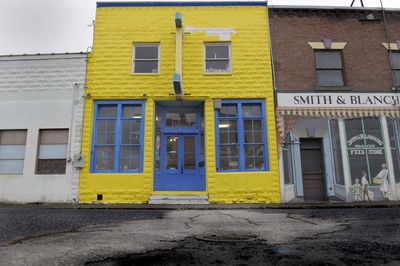Hillyard Laundry Building has colorful past

For a structure listed on the Spokane Register of Historic Places, the Hillyard Laundry Building at 3108 E. Olympic Ave., between Market and Green streets, is remarkably – well, colorful.
Painted bright yellow with an even brighter blue trim, this two-story, formed-concrete block structure was built a stone’s throw from the railroad tracks in 1906 by blacksmith Charles Carr. It was the longtime home of a hand laundry operated by a group of Japanese immigrants.
Fred Shiosaki, who was Spokane’s air pollution control officer in the 1960s and ’70s and Washington Water Power’s environmental safety and health officer after that, knows the building well. His father, Kisaburo “Kay” Shiosaki, brought his bride, Tori, from their native Japan to the Hillyard area and operated the laundry with some partners, becoming the sole proprietor in about 1917. The couple raised their four sons and one daughter for many years in the two-bedroom apartment upstairs.
Kay picked up work clothes, butcher aprons and other garments from neighboring businesses in the booming railroad town that was Hillyard in those days; Tori did the mending. And they both did the hand washing and ironing. Later, as machines and dry cleaning equipment became available, the laundry grew to incorporate modern technology.
“Everybody worked at something,” Fred Shiosaki, now 84, remembers. “I learned how to press clothes, and later, when I was in college at Gonzaga (he earned a chemistry degree in 1949), I’d come home after class and work in the laundry.”
He especially remembers the days before World War II when the building’s steam boiler was fueled by cord wood. Huge pieces of wood had to be cut into 18-inch lengths, a chore which fell to the Shiosaki brothers.
“I am a 6-foot, 8-inch lumberjack housed in a 5-foot, 6-inch body,” Shiosaki said, “and I still have that buck saw.”
His father, who first came to America indentured to the Oriental Trading Co. of Seattle, worked for the Canadian Pacific and Great Northern rail lines and then as a busboy at the Davenport Hotel. He returned to his village in Japan for a bride, who was arranged for him through a marriage broker.
Their children, all born in Spokane, worked in the business, too. “My father had a solid work ethic, which was that everybody worked at something,” Shiosaki said.
But when Pearl Harbor was bombed by the Japanese on Dec. 7, 1941, business took a sharp downward turn as many customers stopped doing business with them, “and it looked like we were going to starve there for a few months,” Shiosaki said.
But that didn’t last long, as neighbors and railroaders and other business people began to bring their laundry back. “We did a lot of work clothes,” Shiosaki said. “There weren’t too many dress shirts in Hillyard in those days, and my parents did good work.”
The family was not sent to internment camps because they lived in the eastern portion of the state. Japanese nationals who lived west of Wenatchee were required to be rounded up and sent to the camps.
But, for years, Kay and Tori were not allowed to become American citizens. However, in 1952 when the McCarran-Walter Act allowed first-generation Japanese immigrants to become naturalized citizens, Shiosaki’s parents did just that.
Tori Shiosaki passed the exam, along with her husband, and they proudly became citizens. Still, alien land laws at the time prohibited them from purchasing the building in which they lived and made their living. In time, they were able to purchase it in the name of their daughter Blanche.
Despite some hard times, Shiosaki recalls Hillyard as a “great place, with the railroad as the driving force, where everybody worked, even during the Depression. It was a place populated with hard working men and women, including immigrants from Italy, England, Germany and everywhere.”
Kay operated the laundry until his death in 1957, after which his son Roy took over, operating it until it was sold in the 1990s to another cleaning business. Roy stayed on to manage the business for several years. And when that business closed, a book store moved in – and is still in operation there.
But there is still the sign out front – “Hillyard Laundry Building, established 1906” – appropriately acknowledging the colorful history of this brightly colored building.